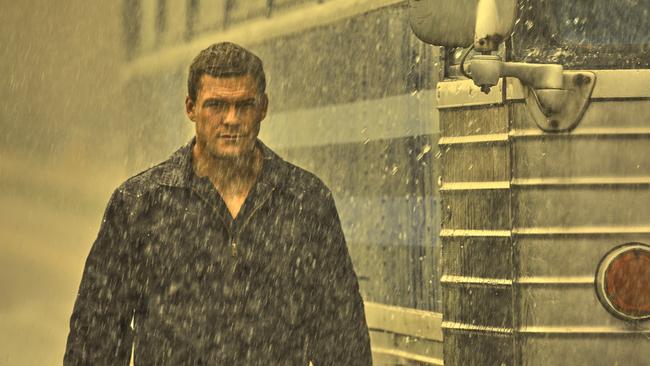Reacher a big and tough act to follow
This impressive TV adaptation of Lee Child’s bestselling Jack Reacher novels holds true to form.

The hit TV show of the moment is Amazon Prime’s crime series Reacher which debuted earlier this month. It’s reported that in the first three days the series ranked among the streamer’s top five most-watched series ever internationally, “spreading like wildfire” according to Amazon, with many viewers finishing all eight episodes during the first 24 hours of release. Its somewhat unexpected success led to its speedy renewal only days later.
Jack Reacher, is of course novelist Lee Child’s hero of epic proportions, the ex-MP drifter with the seldom-talked-about past, who has an almost psychotic obsession with being his own man, no fixed address, and carries nothing but, almost literally, the shirt on his back. And a folding toothbrush. The supremely chivalrous superman journeys America, taking in its rural dusty towns with eyes, “that could blink and come back different, like changing the channel, from a happy show to some bleak documentary about prehistorical survival a million years ago”.
He’s taciturn and somewhat monosyllabic but his brain never stops evaluating, calculating and assessing the moment. “Everyone calls me Reacher,” he says insistently, at the start of the inaugural season of the series. “It’s just Reacher.”
Appropriately the novel the series begins with is Killing Floor, the first of 26 Reacher adventures in Lee Child’s highly successful series, a new book a season projected for the future. “I felt Killing Floor was the logical choice because that book is set not long after Reacher is mustered out,” says Child. “He’s just left the army, he’s learning to be himself, tackling his new life and figuring it out. So it was a natural introduction, a natural beginning.
For a new show, for the viewers, it made total sense – let’s watch it happen in real time.”
And as in the books, played with just the right touch by the huge Alan Ritchson (Blood Drive, Smallville), he’s entertainingly dispensing his own brand of justice transcending the tawdry and corrupt routines of society’s legal systems. He’s an example of the American protagonist continually placed in situations where some sort of violence or criminality becomes a moral necessity, a story pattern going back to the dime novel.
Child’s Reacher books are spare and tight but cunningly evoke many other writers with their sense of place, and Reacher’s heroic altruism. There’s even a touch of Mickey Spillane with the grisly violence and rushing pace. “A good thriller draws you in and makes you feel as if you’re reading faster than the action is occurring on the page,” Child says of his taut and brutal tales. Not an easy thing to do, but something he accomplishes with surprising dispatch. There is, in fact, something eerily unnerving about Child’s remarkable ability to hook us with plot, scary how he builds so much out of such sparse details.
And this adaptation from Nick Santora, a writer with a long history of involvement in action series like Scorpion and Prison Break, gets it just right, even though turning a well-loved series of novels into a TV series is fraught with risks.
There are a number of directors working on different episodes, the first directed by Thomas Vincent, better known for his directorial work on the hit thriller Bodyguard. The cinematography is from Ronald Plante who gorgeously captures the setting of a small town on the Florida-Georgia line, a kind of neo-Western place that’s a testing ground of character and idea, a symbolic landscape of vastness and openness. And there’s a terrific atmospheric score from composer Tony Morales who captures the sense of dread and menace as Reacher becomes involved in some typically nefarious activities.
And together with Santora, they manage somewhat effortlessly to do justice to the nuances of Child’s books, with the author as executive producer “a guardian angel” according to the showrunner, making sure no one deviates too much from the original.
They share with Child the simple time-tested notion that the key to thrillers is vicarious pleasure. And the TV series, like the novels, operates from that fundamental narrative arc that goes way back in the human brain: the thrill of danger, peril, and then resolution and safety. Child arrived with an ability to construct a narrative that embodies in heightened form the pure skeleton of the hard-boiled structure, something that Santora fully appreciates in his adaptation.
Child has always had a visceral feel for the essential pattern of action and theme that underlies the hard-boiled story and is able to express this form with great simplicity and force.
The series is certainly an improvement on the two Reacher movies starring the diminutive Tom Cruise, hardly Child’s gargantuan creation, often described in the books as having hands the size of turkeys or dinner plates. (“How did we find Alan Ritchson?” Santora says somewhat rhetorically. “We just looked out our windows and saw him – because he’s so gigantic, you can see him from anywhere.”)
The first episode, which sparely incorporates flashbacks to Reacher’s childhood, moments taken from the later novels, begins with a rushed murder just below an underpass, a man beaten so severely he might be unrecognisable when discovered. It’s a violent and disturbing opening, the body unceremoniously covered with a box.
We then see Reacher getting off a bus and walking a little stiffly with the distinctive gait of a former military man, along the road and past a sign that says “Welcome To Margrave”, the title of the episode.
We later learn he’s there because his brother Joe once told him that it’s the place where the legendary blues musician, Blind Blake, might have died. (Blake was in fact an accomplished blues guitarist and singer who lived in the early part of the twentieth century, known for his distinctive ragtime style and is credited with helping to establish the Piedmont Blues style of playing with a light touch and a jaunty swing and a touch of the banjo. (Like Reacher, Child too is a blues aficionado.)
Reacher wanders into town and, after ordering peach pie at the diner, he’s suddenly surrounded by anxious cops brandishing their weapons and pulled in for murder. He’s bound by zip ties – standard issued cuffs don’t fit around his huge wrists – and hauled into police headquarters without speaking. It’s quickly discovered he has only $212, a folding toothbrush, a Second World War medal from France that gives us insights into the backstory of his family – “Why does trouble always find you, Reacher?” his mother asks him as a boy in a flashback – and a passport.
He’s processed by detective Oscar Finley (Malcolm Goodwin) and a cluey female cop called Roscoe Conklin (Willa Fitzgerald) who, after an online search, discovers Reacher has no social media footprint – he only exists because he is sitting in the next room. Reacher breaks his silence for the first time. He doesn’t need a lawyer he says, because, “I didn’t kill anybody – at least not recently, and not in this town.” Then when local business accountant Paul Hubble confesses, somewhat unconvincingly, we are off on a violent Reacher adventure, the huge man an unofficial investigator unravelling the town’s secrets.
It’s very well done, Santora’s dialogue taut and specific, the performances all in tune with Child’s heightened sense of realism, and Ritchson quickly makes the character of Reacher his own. He not only gets the intensity right, that abrupt directness of manner, but also the droll humour, speaking in a rather deadpan fashion, often out of the side of his mouth as if not used to talking. It’s as if he is delivering a disquisition – a word, according to his biographer, Child used of the as-yet-unnamed hero in early planning notes – “in a rapid-fire monotone suggestive of someone whose Holmesian mind works faster than his mouth.”
It’s part of the way Santora overcomes the fact that the books are written in the first person, Reacher the narrator, everything in his head, his brain constantly racing with ratiocination, that process of measured thinking so distinctive to detectives. It’s a word Edgar Allan Poe revived from the 17th century and is said to have called his 1841 story “The Murders in the Rue Morgue” his first “tale of ratiocination”, arguably the original detective story.
And Santora cleverly shares Reacher’s mental reasoning among the other principle characters. “The characters are sounding boards for each other, they’re finishing each other’s sentences, and that’s the way for Reacher’s internal processes to be out there on the screen,” Child says. “Interesting as it might have been we couldn’t just have had eight-minute shots of Alan thinking, that doesn’t work visually. The way they did it is terrific, and you never feel it’s artificial.”
It is truly a TV success story, one that as a long term Lee Child fan I could seriously never have imagined.
Reacher streaming on Amazon Prime.




To join the conversation, please log in. Don't have an account? Register
Join the conversation, you are commenting as Logout